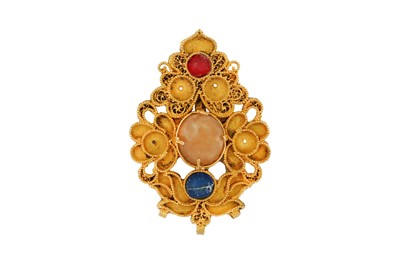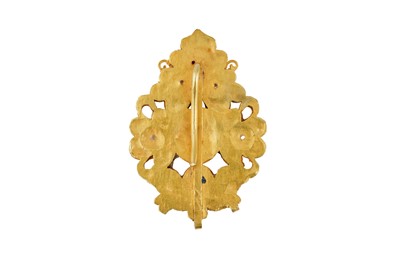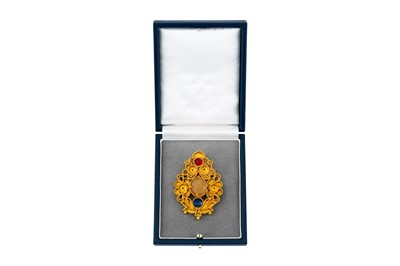28th Apr, 2023 14:00
Islamic & Indian Art
A GOLDEN HORDE BEJEWELLED GOLD FILIGREE PECTORAL
Possibly Qipchaq steppe, Central Asia, late 13th - 14th century
A GOLDEN HORDE BEJEWELLED GOLD FILIGREE PECTORAL
Possibly Qipchaq steppe, Central Asia, late 13th - 14th century
In the shape of a lobed floral medallion, made of gold sheet and wire, box-constructed with sheet back panels, openwork side walls, and spiral filigree and granulation in the front, encrusted with two coloured glass beads (red and blue) in high collar settings and a central oval cabochon-cut quartz in a claw mount, flanked by four smaller pierced roundels once possibly set with gems, the remaining openwork sections possibly once in-filled with enamels, presenting a lotus flower at the base, two lobed rosettes on the sides and a cusped trefoil pattern at the top, the spiral filigree producing minute scrolling vegetal meanders, the edging embellished with granulation, three pierced lugs at the bottom, the plain sheet back with a curved hook, 5.5cm x 4cm.
This rare and precious pectoral comes from a time of great changes and frictions within the Islamic Lands. Indeed, the late 13th and 14th centuries saw the fall of the Medieval status quo and the consequent rise and development of three major powers: the Golden Horde Jochids, centred in the Qipchaq steppe and territories mostly belonging to modern-day Eastern Europe and Russia; the Ilkhanids in Greater Iran; and the Mamluks in Egypt and Syria. Culturally speaking, all three powers were highly cosmopolitan, vaunting colonies of Byzantine, Genoese, Russian, and Armenian craftsmen and merchants in Crimea; Venetians in Tabriz; and nearly all the traders of the Mediterranean shores in Damascus and Alexandria (M. Spink, ‘Golden Horde, Mamluk and Ilkhanid Jewellery’, in The Art of Adornment: Part II, Khalili Collection of Islamic Art, 2013, p. 383). Influences from Mongolia and China were also deeply felt and showcased in the artistic output of these powers, as testified by the ubiquitous presence of Chinese-inspired motifs like lotuses, peonies, and dragons, and the preference for rounder and lobed shapes, instead of angular.
This lot and the next two are of great importance, given how rarely jewellery of this period, and even more so, of the Golden Horde Jochids, is offered at auction. Most of these precious artefacts were excavated by Russian archaeologists in a survey that took longer than 150 years to complete (ibidem, p. 386). Among the most prominent hoards, one could name the ‘Bukhara hoard’, consisting of five gold objects including filigree and granulation work; and the ‘Simferopol hoard’, yielding 328 objects of gold and silver, almost all of which are jewellery.
The art, and especially the jewellery, of the Golden Horde provides us with a powerful insight into the dramatis personae of the Jochids and Chingiz Khan’s descendants. Influenced by Byzantine models, enthused by Chinese motifs, and aiming to match their Middle Eastern counterparts, their arts boasted a truly international character, which had a deep and long-lasting impact in Russia and Central Asia. Their preferred metal appears to have been gold, which was duty-free and never used for coinage (mostly made of silver and copper, and barter was still accepted as an official form of payment). Various historical accounts record that the Jochids would buy large quantities of gold thread from Genoese ships, and gold sheets from Iran, India, and the Caucasus (B. Spuler, Die Goldene Horde: Die Mongolen in Russland 1223 – 1502, 1965, pp. 407 – 408). Traditional Russian jewellery made of precious metal is still characterised today by great splendour and richness, achieved through lavish use of gems and filigree, and a brilliance of colour derived from skilfull polychrome enamelling, all features which first converged in the Golden Horde bejewelled artworks (Cyril G. E. Bunt, Russian Art from Scyths to Soviets, 1946, p. 140).
Our pectoral shows striking analogies with another attributed to the production of the Golden Horde Qipchaq steppe, now in the Khalili Collection of Islamic Art (acc. no. JLY 506). Both pectorals are box-constructed; backed with plain precious metal foils (Khalili silver; our gold); set with gems; and decorated with filigree. However, unlike the Khalili example, the present lot showcases the use of granulation for the edging, a much finer technique than the paired rope design on the Khalili pectoral. The presence of the decorative triad ‘spiral filigree – granulation – gems’ in our lot indicates an earlier date and according to Kramarovsky’s classification, this pectoral should fall into 'Golden Horde Group 2', dating from the late 13th to the early 14th century (for the full article and list, please see M. G. Kramarovsky, ‘The Origin and Influence of Spiral-Filigree Jewellery’, in The Art of Adornment: Part II, Khalili Collection of Islamic Art, 2013, pp. 404 – 411). It is believed that objects of Group 2 were made by the first generation of goldsmiths in the Golden Horde. These can often be mistaken for Group 4, produced in Mamluk Egypt and Syria later in the 14th century, but usually, Mamluk examples do not showcase any granulation.
Do you have an item similar to the item above? If so please click the link below to submit a free online valuation request through our website.



